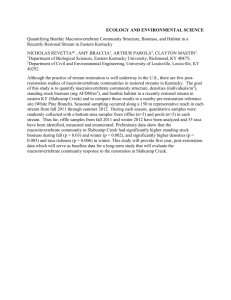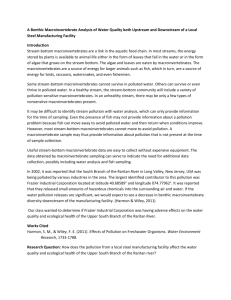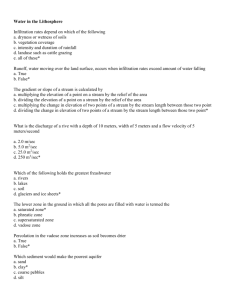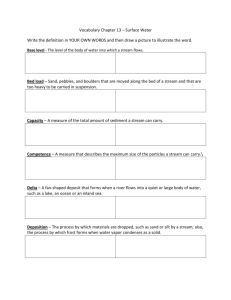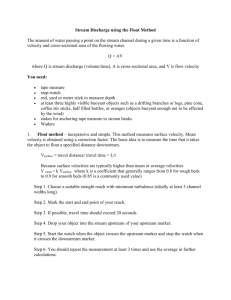File
advertisement
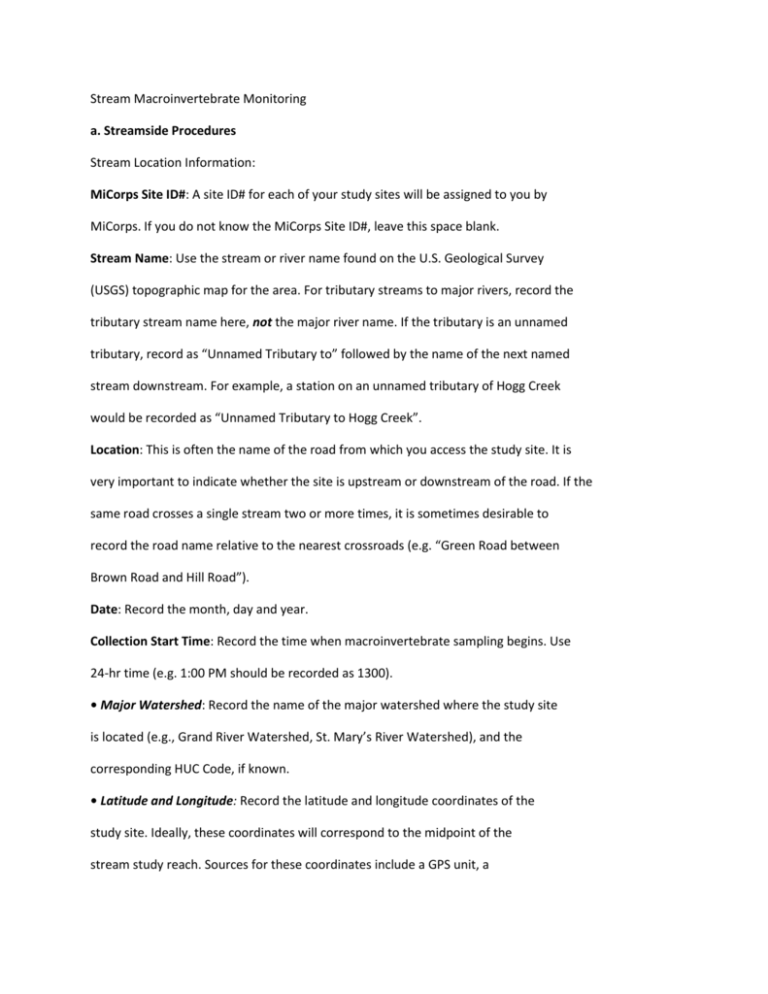
Stream Macroinvertebrate Monitoring a. Streamside Procedures Stream Location Information: MiCorps Site ID#: A site ID# for each of your study sites will be assigned to you by MiCorps. If you do not know the MiCorps Site ID#, leave this space blank. Stream Name: Use the stream or river name found on the U.S. Geological Survey (USGS) topographic map for the area. For tributary streams to major rivers, record the tributary stream name here, not the major river name. If the tributary is an unnamed tributary, record as “Unnamed Tributary to” followed by the name of the next named stream downstream. For example, a station on an unnamed tributary of Hogg Creek would be recorded as “Unnamed Tributary to Hogg Creek”. Location: This is often the name of the road from which you access the study site. It is very important to indicate whether the site is upstream or downstream of the road. If the same road crosses a single stream two or more times, it is sometimes desirable to record the road name relative to the nearest crossroads (e.g. “Green Road between Brown Road and Hill Road”). Date: Record the month, day and year. Collection Start Time: Record the time when macroinvertebrate sampling begins. Use 24-hr time (e.g. 1:00 PM should be recorded as 1300). • Major Watershed: Record the name of the major watershed where the study site is located (e.g., Grand River Watershed, St. Mary’s River Watershed), and the corresponding HUC Code, if known. • Latitude and Longitude: Record the latitude and longitude coordinates of the study site. Ideally, these coordinates will correspond to the midpoint of the stream study reach. Sources for these coordinates include a GPS unit, a topographic map, or digital maps, such as www.topozone.com. Monitoring Team: Record the name of the person completing the datasheet, the person doing the actual in-stream macroinvertebrate collecting, as well as other team members participating in the assessment. Stream Conditions: Average Water Depth : This value can be taken from the Stream Habitat Assessment datasheet, if completed at the same time. Otherwise, to measure average water depth (ft), three measurements should be made at random points along the representative reach length being surveyed, and these values averaged for a mean depth. Siltation: Some siltation along stream margins is normal. However, silt that settles on gravel, cobble, and woody debris in the main stream channel can have a negative impact on the benthic invertebrates that colonize these substrates and also can affect fish reproduction. Note on the data form whether there is obvious siltation on the dominant substrate types in the main stream channel. Embeddedness: Embeddedness refers to the extent to which gravel, cobble, or boulders are surrounded or covered by fine material (such as silt or sand). The more the substrate is embedded, the less its surface area is exposed to the water and available for colonization by invertebrates. Record the appropriate level of embeddedness observed in the stream reach. This is measured as the percentage of an individual substrate piece, such as a rock, that is covered on average. Fish or Wildlife: During the macroinvertebrate survey, volunteers should take note of any fish or wildlife (frogs, turtles, ducks, etc.) that may be visible in or near the stream and document any observations on the survey form. Note if any crayfish or large clams, that would not fit in the sample jar, were found at the site but not collected. Many freshwater clams are rare or endangered, and should not be disturbed. Remember, however, to include these organisms in the Stream Quality Score on the second page of the data sheet. Macroinvertebrate Collection: The sampling effort expended to collect benthic macroinvertebrates at each site should be sufficient to ensure that all types of benthic invertebrate habitats are sampled in the stream reach. This generally will be about 30 minutes of total sampling time per station. Macroinvertebrate samples should be collected from all available habitats within the stream reach using a dip net with a one millimeter (mm) mesh, a kick screen made from doweling and window screening, or by hand picking. Habitat types can include riffles, pools, cobbles, aquatic plants, runs, stream margins, leaf packs, undercut banks, overhanging vegetation, and submerged wood. Habitat and substrate types from which macroinvertebrates were collected (or collections were attempted) should be recorded on the form; include as many as possible. Collecting should begin at the downstream end of the stream reach and work upstream. All organisms collected should be placed into a bucket or tray. The composite sample should be rinsed and all large pieces of debris removed. The remaining sample contents should be emptied into enamel or plastic pan(s) with a light-colored bottom. The team of volunteers should then sort through the collection and place the macroinvertebrates into jar(s) of 70% ethanol preservative for later identification. Volunteers should be shown how to pick through the tray, and to inspect rocks and other debris, emphasizing hidden locations under bark and in caddisfly cases. Be sure that every jar has a label written in pencil and placed inside the jar. It is recommended that all individuals collected be placed in the sample jar. However, in cases where there are VERY large numbers of clearly identical organisms, no more than approximately 15 individuals need to be included in the collection. ** While macroinvertebrates collected from the stream can be identified to order in the field by experienced collectors, the collected organisms must still be preserved in labeled sample jars and retained by the volunteer monitoring program for verification purposes. See “Macroinvertebrate Monitoring: Is It Good for the Stream?” in the MiCorps Monitor, Issue 2 (April 2006) for more information (www.micorps.net/newsletter.html) **

